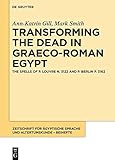Transforming the Dead in Graeco-Roman Egypt : The Spells of P. Louvre N. 3122 and P. Berlin P. 3162 / Ann-Katrin Gill, Mark Smith.
Material type: TextSeries: Zeitschrift für ägyptische Sprache und Altertumskunde – Beihefte ; 16Publisher: Berlin ; Boston : De Gruyter, [2023]Copyright date: ©2023Description: 1 online resource (XI, 175 p.)Content type:
TextSeries: Zeitschrift für ägyptische Sprache und Altertumskunde – Beihefte ; 16Publisher: Berlin ; Boston : De Gruyter, [2023]Copyright date: ©2023Description: 1 online resource (XI, 175 p.)Content type: - 9783111079837
- 9783111098876
- 9783111096933
- 299.3
- online - DeGruyter
- Issued also in print.
| Item type | Current library | Call number | URL | Status | Notes | Barcode | |
|---|---|---|---|---|---|---|---|
 eBook
eBook
|
Biblioteca "Angelicum" Pont. Univ. S.Tommaso d'Aquino Nuvola online | online - DeGruyter (Browse shelf(Opens below)) | Online access | Not for loan (Accesso limitato) | Accesso per gli utenti autorizzati / Access for authorized users | (dgr)9783111096933 |
Browsing Biblioteca "Angelicum" Pont. Univ. S.Tommaso d'Aquino shelves, Shelving location: Nuvola online Close shelf browser (Hides shelf browser)
Frontmatter -- Contents -- Acknowledgements -- Abbreviations -- Introduction -- 1 The history of the manuscripts, their acquisition and present location -- 2 Material description: dimensions and joins, number of columns of text, number of vignettes -- 3 Description of the writing on the papyri and its layout -- 4 The scribe of P. Louvre N. 3122 and P. Berlin P. 3162! -- 5 Provenance and date of the manuscripts -- 6 The owners of the papyri, their titles, and their families -- 7 Contents of the papyri -- 8 Posthumous transformation in ancient Egyptian thought -- 9 Context of usage of the papyri -- 10 Orthography -- 11 Grammar -- 12 Edition -- 13 Glossaries -- Bibliography of works cited -- Indice -- Plates
restricted access online access with authorization star
http://purl.org/coar/access_right/c_16ec
The belief that dead people could assume non-human forms is attested in Egyptian texts of all periods, from the Old Kingdom down to Graeco-Roman times. It was thought that assuming such forms enhanced their freedom of movement and access to nourishment in the afterlife, as well as allowing them to join the entourages of different deities and participate in their worship. Spells referring to or enabling the deceased’s transformations occur in the Pyramid Texts, the Coffin Texts, and the Book of the Dead. But it is not until the Graeco-Roman Period that we find entire compositions devoted to this theme. Two of the most important are P. Louvre N. 3122 and P. Berlin P. 3162, both written in hieratic and dating to the 1st century AD. Both texts have been known to Egyptologists for more than a century, but neither is currently available in an up-to-date comprehensive edition. This book provides such an edition, including high-resolution images of the manuscripts, hieroglyphic transcriptions, translations, descriptions of their material aspects, studies of their owners, their titles, and their families, reconstructions of their context of usage, analyses of their orthography and grammar, and detailed commentaries on their contents.
Issued also in print.
Mode of access: Internet via World Wide Web.
In English.
Description based on online resource; title from PDF title page (publisher's Web site, viewed 06. Mrz 2024)









